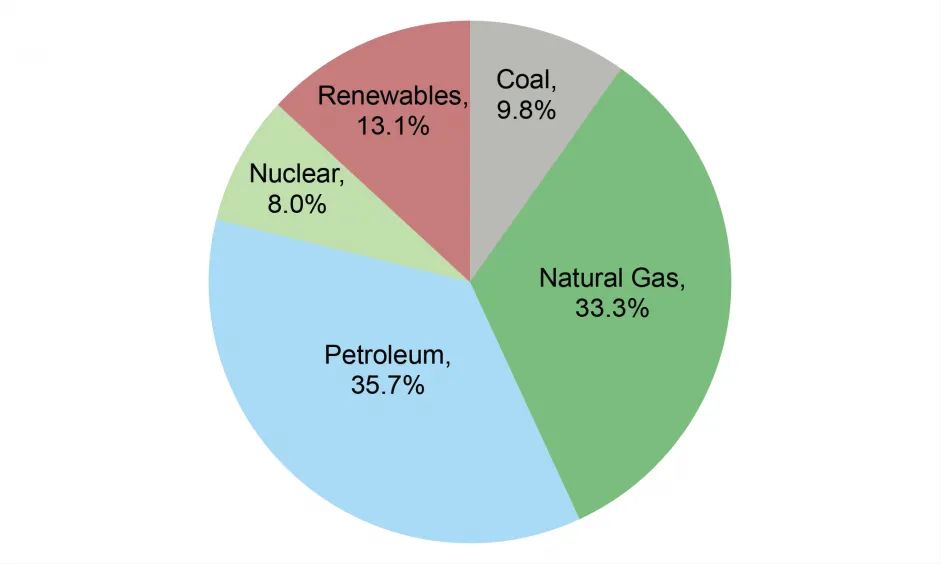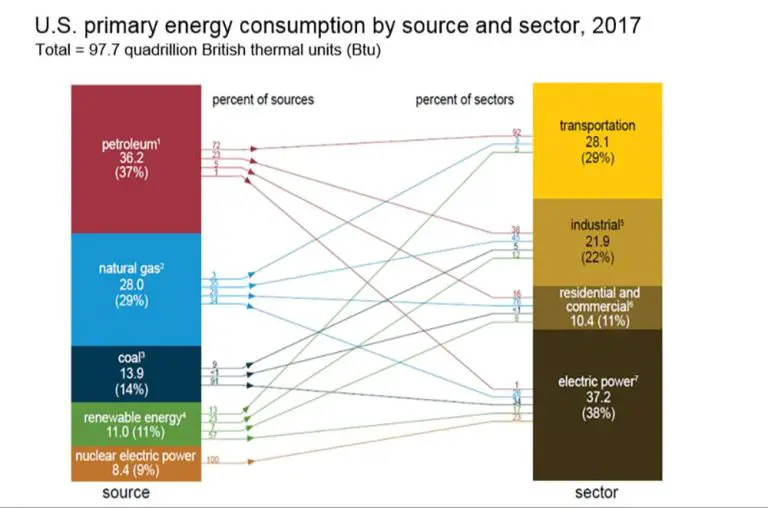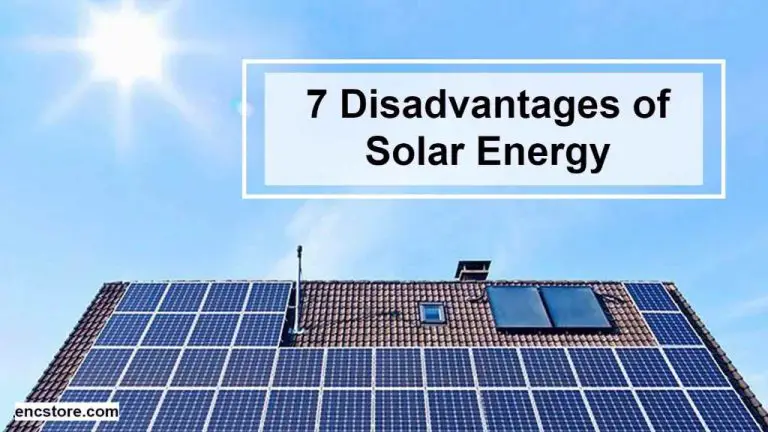How Efficient Is The Us Energy System?

Energy efficiency refers to using less energy to provide the same service. For example, when a compact fluorescent lightbulb (CFL) replaces an incandescent lightbulb, less energy is used to produce the same amount of light. Energy efficiency improvements enable us to use less energy while maintaining or improving the quality of services that energy provides. Energy efficiency helps curb energy consumption and emissions.
The United States is the second largest energy consumer after China. In 2021, total U.S. primary energy consumption was about 97.5 quadrillion British thermal units (Btu). The industrial sector accounted for the largest share of U.S. end-use energy consumption in 2021 at 31%, followed by transportation at 29% and residential and commercial at 40%.
Two common metrics used to measure and compare national energy efficiency are Energy Use Intensity (EUI) and the Energy Sustainability Index (ESI). EUI measures energy consumption per square meter of floor space, which controls for structural differences between countries. ESI measures progress towards global sustainable energy development by accounting for environmental impacts, energy security, and energy equity.
Total Energy Consumption
The total energy consumption in the United States in 2022 was about 97 quadrillion British thermal units (Btu). Of this, about 40% came from petroleum, 32% from natural gas, 12% from coal, 11% from renewable energy, and 5% from nuclear electric power.
Per capita energy consumption in the US is among the highest in the world, at about 293 million Btu in 2019. This is nearly double the world average of 109 million Btu per capita.
Historically, total energy consumption in the US grew rapidly in the post-war period, more than doubling between 1950 and 1973. Growth slowed after the 1973 oil crisis but resumed through the 1990s and 2000s. Since 2007, energy consumption has declined slightly, mainly due to improvements in energy efficiency across sectors.
Source: U.S. energy facts explained – consumption and production
Electricity Generation
Electricity generation in the U.S. has changed dramatically over the past 70 years. According to data visualized by Visual Capitalist, coal provided 93% of electricity generation in 1950, while in 2021 it only accounted for 22%. Natural gas has grown from providing 1% in 1950 to 38% in 2021. Renewable energy sources like wind, solar, hydroelectric, biomass and geothermal have also increased, going from virtually 0% in 1950 to 20% in 2021.
Despite the growth in renewables, the majority of U.S. electricity generation still comes from fossil fuels. In 2020, fossil fuels accounted for 60% of total U.S. electricity generation, with natural gas providing 40%, coal 20%, and petroleum under 1%. Nuclear power provided 20%, while renewables accounted for 20% – with the largest shares from hydropower (7%), wind (8%) and solar (3%).
Fossil fuel electricity generation produces significant emissions, contributing to climate change. In 2020, electricity production accounted for 25% of total U.S. greenhouse gas emissions. Transitioning more electricity generation to renewable sources and nuclear could help reduce emissions from the power sector.
Transportation Efficiency
Fuel economy standards have significantly improved the efficiency of vehicles in the United States. New standards finalized in 2022 will increase fuel efficiency 8% annually for model years 2024-2025 and 10% annually for model year 2026, resulting in an estimated fleetwide average of around 49 mpg for passenger cars and light trucks in 2026, up from 38.3 mpg under the previous standards (1). However, the US still lags behind many other developed countries in implementing strict fuel economy standards.
Use of public transportation in the US remains low compared to other developed countries. Only about 5% of commuters use public transit as their primary mode of getting to work (2). Expanding and improving public transportation infrastructure could greatly reduce energy usage in the transportation sector.
Electric vehicle adoption is rising quickly, with EVs making up over 5% of new vehicle sales in 2022, more than double from 2020 (3). This growth is being driven by falling battery costs, wider model availability, and government incentives. Further policy support and charging infrastructure development will be needed to continue the transition to electric vehicles and realize their energy efficiency benefits.
Sources:
(2) https://www.apta.com/research-technical-resources/public-transportation-facts/
Buildings Efficiency
Buildings account for about 40% of total U.S. energy consumption, with residential buildings using about half of that and commercial buildings using the other half. There are key differences in energy use between residential and commercial buildings.
Residential energy is used primarily for space heating, cooling, water heating, lighting, refrigeration, and appliances. The energy efficiency of residential buildings can be improved through measures like weatherization, upgrading to ENERGY STAR certified heating/cooling systems and appliances, and switching to efficient lighting like LEDs. Building energy codes and standards like ASHRAE 90.1 help drive efficiency in new construction and renovations.
Commercial building energy is used for many of the same needs as residential buildings, plus additional loads like office equipment, restaurants, and data centers. Energy efficiency can be improved through retrofits to building envelopes like windows, insulation, and roofs. Upgrading HVAC and lighting systems to more efficient technologies plays a major role. Building automation systems help optimize energy use. Onsite renewable energy like solar PV also helps reduce grid electricity use.
Smart meters and grid technologies like demand response programs are important for both residential and commercial buildings. Smart meters provide real-time energy use information to help identify savings opportunities. Demand response allows adjustment of energy use during peak times to reduce strain on the grid and be more cost effective.
Industrial Efficiency
The energy intensity of U.S. manufacturing has declined over the past few decades as industrial processes have become more efficient. According to the U.S. Energy Information Administration, energy intensity in the industrial sector declined by 21% between 2010 and 2020 (EIA). This is largely due to more widespread adoption of energy-efficient technologies and practices. The U.S. Department of Energy has several programs aimed at accelerating the use of efficient technologies in industry, such as motor, steam, and process heating systems (DOE).
Some common industrial energy efficiency measures include waste heat recovery, cogeneration, advanced electric motor systems, and efficient compressed air systems. Waste heat recovery involves capturing heat generated during industrial processes and using it for heating or electricity generation rather than letting it escape into the atmosphere. This allows manufacturers to extract additional value from wasted thermal energy. According to the DOE, waste heat recovery has the potential to reduce industrial energy consumption by 10-50% (DOE).
Overall, increased adoption of mature, cost-effective energy efficient technologies and continued improvements in manufacturing processes can lead to further reductions in U.S. industrial energy intensity.
Policy and Regulation
The U.S. government has implemented various policies and initiatives to improve energy efficiency across sectors. Some key efforts include:
Efficiency standards and targets: The Department of Energy has established minimum energy efficiency standards for appliances, lighting, and equipment like furnaces, boilers, and air conditioners. These standards eliminate the least efficient products from the market (source: https://www.energy.gov/scep/slsc/energy-efficiency-policies-and-programs). The DOE also sets energy reduction targets for federal agencies.
Incentives and rebates: There are tax credits, rebates, and other financial incentives available to help consumers and businesses adopt energy efficient technologies and improvements. The federal government offers tax credits for home efficiency improvements, while state/local programs provide rebates on items like efficient appliances (source: https://www.energy.gov/energysaver/financing-and-incentives).
Government initiatives: The EPA ENERGY STAR program labels efficient products, while the DOE Weatherization Assistance Program helps low-income families improve home efficiency. The government also sponsors initiatives like “Race to Zero” student competitions for energy efficiency (source: https://www.energystar.gov/about/federal_tax_credits).
Energy Productivity
Though US energy consumption decreased during the years following the 2008 recession, over longer periods of time total US energy use has continued to increase. The US currently consumes over 100 quadrillion Btu of energy from all sources annually. However, energy productivity (measured as economic output per unit of energy input) has been increasing as well. According to https://bcse.org/market-trends/top-trends/, US energy productivity grew 15.2% from 2010 to 2020. This indicates the US economy is able to produce more economic output with the same or lower energy inputs over time.
Compared to other developed countries, the US ranks relatively low in terms of energy productivity. According to the American Council for an Energy-Efficient Economy (ACEEE), the US ranked 8th out of 25 major economies in 2020. Many European countries such as Italy, the UK, and Germany ranked higher in energy productivity. The US can continue improving energy productivity through investments in more efficient technology, renewable energy, and conservation.
Challenges and Opportunities
While the US has made significant strides in improving energy efficiency, there are still areas needing improvement. The building sector accounts for about 40% of total US energy consumption, yet many older buildings are energy inefficient. Retrofitting these buildings with insulation, energy-efficient windows, lighting, and HVAC systems could unlock major energy savings (EPA). The industrial sector is also ripe for efficiency gains through technologies like combined heat and power systems.
Emerging technologies like smart meters, building automation systems, and data analytics are creating new opportunities to monitor energy use in real-time and identify savings. The Department of Energy forecasts that investment in energy efficiency improvements could reduce national energy use by over 50% by 2050 (McKinsey).
While progress has been made, experts project the need for continued advancement in policies, financial incentives, building codes, and public awareness to tap the full potential of energy efficiency. With persistent effort across sectors, the gains in cost savings, energy security, job creation and emissions reduction from improved efficiency could be immense.
Conclusion
Energy efficiency is vital for a sustainable future and has increased in most sectors of the US economy in recent decades. Key takeaways covered in this article include:
– Total energy consumption in the US has remained relatively flat over the past few decades even as GDP has increased, demonstrating improving energy productivity.
– The electricity generation mix has transitioned towards more efficient natural gas and renewable sources and away from coal.
– Fuel economy standards, EV adoption, and public transportation have made the transportation sector more efficient.
– Buildings have realized major efficiency gains through improved insulation, lighting, heating/cooling systems and smart appliances and sensors.
– Industry has implemented more efficient motors, boilers, HVAC and lighting to curb energy usage.
– Government policies like fuel economy standards and building codes have driven efficiency gains.
While progress has been made, further energy efficiency improvements through continued innovation, investment, and standards will be essential to meet climate goals and ensure affordable, reliable and sustainable energy for the future.




